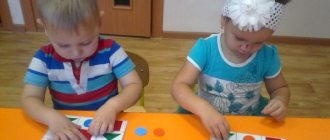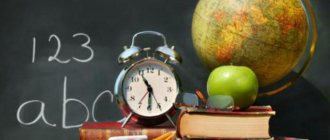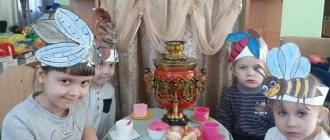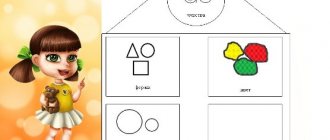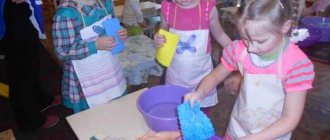Final lesson in mathematics in the senior group (May)
Final lesson in mathematics in the senior group (May)
Purpose: to test children's knowledge.
Objectives: 1. Repeat forward counting within 20 and backward counting within 10. 2. Strengthen the ability to compare numbers using the signs <, >, =. 3. Strengthen the development of visual and auditory attention. 4. Strengthen the ability to solve logical problems. 5. Consolidation of concepts: day, week, year. 6. Consolidate knowledge of planar and spatial geometric figures. 7. Test your ability to navigate on a sheet of squared paper by performing a graphic dictation. 8. Continue to teach how to work carefully in notebooks.
Material: cards with numbers from 1 to 10; signs <, >, =; a card for each child for graphic dictation; models of spatial and plane figures; notebooks with examples for comparing numbers; Stepashka toy.
Progress of the lesson. Part I. Today, guys, we will go to the country of Mathematics. Get ready to go. Please take your tickets and take your seats for your trip. (Children are given tickets in the form of geometric shapes: , , , , and the numbers from 1 to 10 are written on the geometric shapes and the place is also indicated.
For example: - this is a ticket. There is the same number on the back of the chair)
Has everyone taken their seats? Nikita, why did you sit in this place? (Child's expected answer: because I had a ticket in the form of a geometric figure, a circle with the number 1 and the same designation on the chair) Well done, you all did it! And now it’s time for us to go to fairyland. Close your eyes, and Dima will count from 1 to 20. Here we are in the country of Mathematics.
Part II. Oh, hear, it seems like someone is arguing. Yes, these are numbers - they just can’t figure out who is standing where. Let's help the numbers. Arrange the numbers in order from 1 to 10. (The teacher goes through and checks the correctness of the task, sums up the results) Now, using arcs, highlight the numbers that are greater than 2 but less than 7. What numbers did Veronica highlight? (I highlighted the numbers 3,4, 5, 6 with arcs) Read, Sveta, the resulting mathematical notation. (The numbers 3, 4,5, 6 are greater than 2, but less than 7) Similarly, numbers greater than 3, but less than 9 are distinguished; more than 1, but less than 8. It is imperative to ensure that the child clearly pronounces this mathematical notation. Well, you know the numbers well in order, but do you know them scattered? I will hit the tambourine, and you will show the corresponding number, how many times I hit the tambourine. And they completed this task.
Part III. Guys, while you were counting, I received a letter. I wonder who it's from? This is a letter from Tochka, what does it say? (The teacher opens the envelope) There are so many cards and a task - you need to compare numbers. I will give you cards, and you take pencils in your hands and make the appropriate signs. (If the need arises, repeat the signs <, > again) Now check each other whether the task was completed correctly, exchange cards and correct mistakes, if any.
Part IV. Let's see what else is in this envelope. So, in my opinion, these are the tasks. Listen to the first problem. There are 4 apples on the table. One of them was cut in half and placed on the table. How many apples are on the table? (4) There were 5 apples and 3 pears hanging on the tree. How many fruits were on the tree? (0 – apples and pears do not grow on the Christmas tree) Two boys played checkers for 3 hours. How long did each person play checkers? (3 hours) There are 3 glasses of milk on the table. Kostya drank one glass and put it on the table. How many glasses are there on the table? (3) Part V. The teacher takes out the next piece of paper from the letter. Guys, there's some kind of map here. Probably Dot wants to invite us somewhere. Where will we go? Where will we go? And I know, visiting geometric shapes. (Graphic dictation is performed, blanks are distributed to children)
3 cells to the right; 2 squares up; 3 cells to the left; 2 squares up; 4 cells to the right; 1 square down; 3 cells to the right; 2 squares up; 2 cells to the right, 1 cell up, 3 cells to the left; 1 square up; 5 cells to the right; 2 cells down; 2 cells right; 2 cells down; 2 cells right; 1 square down; 1 cell to the right; 1 square down; 4 cells to the right; 3 cells up; 2 cells to the left; 3 cells up; 4 cells to the right; 3 cells down. (The task is checked. An explanation is given; if the child clearly followed the indicated route, then he will come to the point in the upper right corner).
Part VI. Here we are on the street of geometric shapes. What geometric shapes do you know? What are the geometric shapes? (Child’s expected answer: geometric figures are three-dimensional or spatial and planar) Name and show, Grisha, planar figures. (If the child was not correct with the task, ask someone else) (The child’s expected answer: plane figures are a square, a circle, an oval, a rectangle, a triangle, a rhombus, a trapezoid, a parallelogram) Okay, now, Polina, show and name all the three-dimensional ones geometric figures. (Similarly, if there is difficulty, ask someone else) (Child’s expected answer: three-dimensional figures are a sphere, cube, prism, parallelepiped, cylinder, cone, pyramid) Well, now let’s see whose team knows geometric figures better.( A d/i “Geometric Forms” is offered, one for each team) Listen carefully to the task. Place all three-dimensional figures to the right, as well as objects that have the same geometric shape. On the left, place flat geometric figures and objects that have the same shape. (Give teams the opportunity to independently check the results of their opponents. Summing up)
VII part. Guys, don't you hear anything? It seems to me that a clock is ticking somewhere. Follow me, everyone. We found ourselves on the Street of Time. How many of you know how many parts there are in a day? (There are four parts in a day) Name them, Katya, in order. (Child's expected answer: morning, afternoon, evening, night) How many days are there in a week? (Child's expected answer: there are seven days in a week) What is the third day of the week, fourth, fifth, seventh, etc. What is the first day off called? first work day? Last day of work? etc. How many months are there in a year? (There are twelve months in a year) Who can list them in order for me? Well done boys. Oh, yes, there’s some kind of note here: “Dear guys, Autumn, I’m glad that you came to visit us yesterday in the Mathematics camp. It's a pity that you weren't there for the segment's birthday tomorrow. I hope to see you today at the numbers festival. Your point.” Something is wrong here. (Children's expected answer: children must guess that the temporary actions are mixed up) Yes, the words are mixed up here: yesterday, today, tomorrow. Let's rearrange everything. Well, it’s sad, but it’s time for us to return home. Close all your eyes, and Vita will count down from 10 to 1. Here we are at home, but I think that we will visit the wonderful country of Mathematics more than once. Summarizing.

